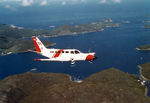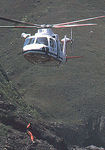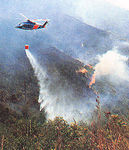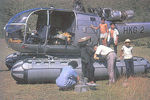Internal Security
 When the HKAAF was formed in 1949 it’s primary function, like that of the other volunteer units, was to assist the British garrison in the defence of Hong Kong. This was reflected in the types of aircraft first flown by the unit: the Austers and Harvards for air observation and support; the Spitfires for photo-reconnaissance and fighter support.
As the 1950s brought increasing security to the region, the Harvards and Spitfires were phased out. However, the unit’s basic internal security role did not change. Far from diminishing, this responsibility expanded in both scope and usefulness.
When the HKAAF was formed in 1949 it’s primary function, like that of the other volunteer units, was to assist the British garrison in the defence of Hong Kong. This was reflected in the types of aircraft first flown by the unit: the Austers and Harvards for air observation and support; the Spitfires for photo-reconnaissance and fighter support.
As the 1950s brought increasing security to the region, the Harvards and Spitfires were phased out. However, the unit’s basic internal security role did not change. Far from diminishing, this responsibility expanded in both scope and usefulness.
 The Royal Hong Kong Police made frequent use of the unit’s aircraft for a variety of tasks, including airlifting patrols in the rural areas, traffic survey and communications, and even for ferrying police dogs to search areas. Regular patrols were flown, with a Marine Police Inspector on board, searching for illegal immigrants and Vietnamese refugees. Although the problem of illegal immigration eased after the second half of 1981, anti-illegal immigrant operations remained an important duty.
RHKAAF fixed-wing aircraft frequently operated far out to sea in support of the Narcotics Bureau for surveillance of suspected drug-smuggling trawlers. The unit was also tasked on operations against street crime and drug trafficking.
The Royal Hong Kong Police made frequent use of the unit’s aircraft for a variety of tasks, including airlifting patrols in the rural areas, traffic survey and communications, and even for ferrying police dogs to search areas. Regular patrols were flown, with a Marine Police Inspector on board, searching for illegal immigrants and Vietnamese refugees. Although the problem of illegal immigration eased after the second half of 1981, anti-illegal immigrant operations remained an important duty.
RHKAAF fixed-wing aircraft frequently operated far out to sea in support of the Narcotics Bureau for surveillance of suspected drug-smuggling trawlers. The unit was also tasked on operations against street crime and drug trafficking.
* * *
Search & Rescue
RHKAAF aircraft were tasked frequently on search and rescue, and on casualty evacuations at sea and on land within the square boundary of Hong Kong and also within 400 miles radius of the Hong Kong Flight Information Region.
 In conducting SAR operations over land, the unit worked very closely with Police and other agencies such as the Civil Aid Services and Fire Services. And to prepare for SAR operations outside Hong Kong waters, the unit performed regular search and rescue exercises to test the response and joint effort between Hong Kong’s rescue units and those of neighbouring countries such as Japan’s Maritime Service and the U.S. Coast Guard.
Over the years the RHKAAF carried out numerous rescue and emergency evacuation tasks, often in severe weather conditions, saving many lives in jeopardy.
The dedication, skill and courage demonstrated by the unit’s aircrew were eloquently documented by the citation which accompanied the Grand Master’s Commendation for 1991, awarded by the Guild of Air Pilots and Air Navigators to the RHKAAF for the “outstanding skill and extreme bravery of the crews” in the DB29 rescue operation.
In conducting SAR operations over land, the unit worked very closely with Police and other agencies such as the Civil Aid Services and Fire Services. And to prepare for SAR operations outside Hong Kong waters, the unit performed regular search and rescue exercises to test the response and joint effort between Hong Kong’s rescue units and those of neighbouring countries such as Japan’s Maritime Service and the U.S. Coast Guard.
Over the years the RHKAAF carried out numerous rescue and emergency evacuation tasks, often in severe weather conditions, saving many lives in jeopardy.
The dedication, skill and courage demonstrated by the unit’s aircrew were eloquently documented by the citation which accompanied the Grand Master’s Commendation for 1991, awarded by the Guild of Air Pilots and Air Navigators to the RHKAAF for the “outstanding skill and extreme bravery of the crews” in the DB29 rescue operation.
* * *
Emergency Operations
 The auxiliary members of the unit enabled it to operate seven days a week, and to provide an emergency standby service at night and during public holidays. When all auxiliaries were in attendance, the RHKAAF could operate all its helicopters and fixed-wing aircraft round-the-clock for a sustained period.
The auxiliary members of the unit enabled it to operate seven days a week, and to provide an emergency standby service at night and during public holidays. When all auxiliaries were in attendance, the RHKAAF could operate all its helicopters and fixed-wing aircraft round-the-clock for a sustained period.
 The usual night emergencies were to lift seriously ill patients to hospital from outlying clinics. However, dawn searches for lost or injured hikers and climbers were all too frequent. Such operations sometimes culminated in winching people from inaccessible places on the rocky hills of the New Territories, or from the many outlying islands, often in bad weather.
After typhoons and other natural disasters, the RHKAAF was kept extremely busy carrying out post-typhoon reconnaissance, flying government officers to survey flooding and damage to property and crops, airlifting supplies, and evacuating casualties.
The helicopters operated by the RHKAAF could be fitted with underslung firefighting buckets, and this capability was put to good use in countryside fire suppression operations.
The usual night emergencies were to lift seriously ill patients to hospital from outlying clinics. However, dawn searches for lost or injured hikers and climbers were all too frequent. Such operations sometimes culminated in winching people from inaccessible places on the rocky hills of the New Territories, or from the many outlying islands, often in bad weather.
After typhoons and other natural disasters, the RHKAAF was kept extremely busy carrying out post-typhoon reconnaissance, flying government officers to survey flooding and damage to property and crops, airlifting supplies, and evacuating casualties.
The helicopters operated by the RHKAAF could be fitted with underslung firefighting buckets, and this capability was put to good use in countryside fire suppression operations.
* * *
Government Flying Support
In addition to emergency flights, the RHKAAF provided helicopter and fixed-wing aircraft and flying services seven days a week in routine tasks for other government departments. In collaboration with the Department of Health, the unit provided regular “flying doctor” and “flying dentist” services to outlying village communities in inaccessible parts of the New Territories.
For the territory’s Buildings and Lands Department, the support usually consisted of aerial photographic survey for map-making and development planning, and transporting personnel, building materials and equipment to remote places for construction projects. Similar assistance was rendered, on repayment, to the private sector for tasks considered to be in the public interest.
In collaboration with the Department of Health, the unit provided regular “flying doctor” and “flying dentist” services to outlying village communities in inaccessible parts of the New Territories.
For the territory’s Buildings and Lands Department, the support usually consisted of aerial photographic survey for map-making and development planning, and transporting personnel, building materials and equipment to remote places for construction projects. Similar assistance was rendered, on repayment, to the private sector for tasks considered to be in the public interest.
 The RHKAAF’s fixed-wing aircraft were used by the Marine Department for the surveillance of oil discharged into Hong Kong waters by passing ships. The fixed-wing aircraft were also used by the Civil Aviation Department in instrument calibration and the checking of runway aids, as well as for the training of air traffic controllers.
VIP work undertaken by the unit was considerable. In addition to members of the Royal Family, the RHKAAF’s past passengers included the Pope, foreign Heads of State, the British and Canadian Prime Ministers, and the British Members of Parliament and government ministers. The Governor of Hong Kong and other officials also used the unit’s services for official visits to outlying parts of the territory.
The RHKAAF’s fixed-wing aircraft were used by the Marine Department for the surveillance of oil discharged into Hong Kong waters by passing ships. The fixed-wing aircraft were also used by the Civil Aviation Department in instrument calibration and the checking of runway aids, as well as for the training of air traffic controllers.
VIP work undertaken by the unit was considerable. In addition to members of the Royal Family, the RHKAAF’s past passengers included the Pope, foreign Heads of State, the British and Canadian Prime Ministers, and the British Members of Parliament and government ministers. The Governor of Hong Kong and other officials also used the unit’s services for official visits to outlying parts of the territory.
* * *